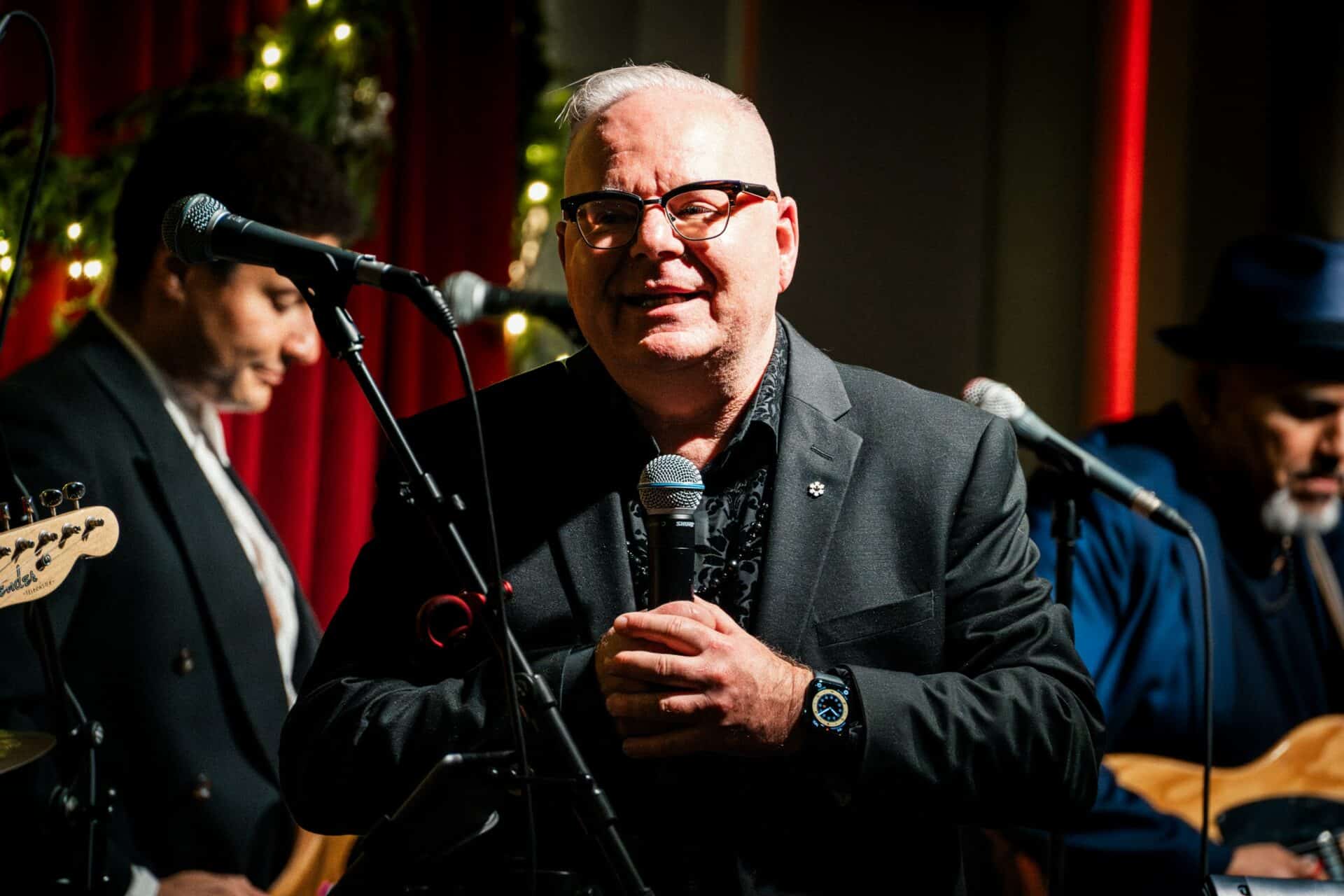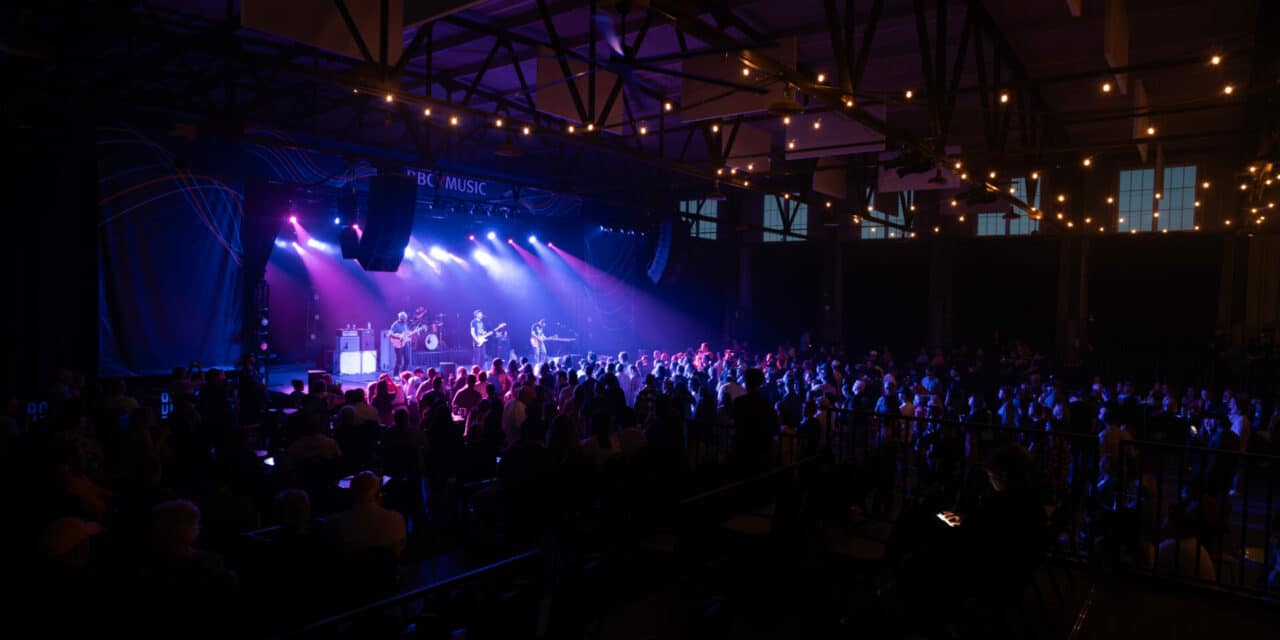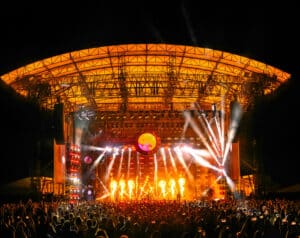DRILL DOWN: Base31, a multi-venue complex located at a former World War II air training base in Prince Edward County, Ontario, includes the 1,500-capacity Drill Hall, shown here during a Tokyo Police Club concert. (Courtesy venue)
70-acre parcel includes 40-plus former military buildings
In Prince Edward County, Ontario, Canada, a paradisiacal setting about two hours east of Toronto, three hours southwest of Ottawa, and 3.5 hours west of Montreal, a former World War II air training base in the town of Picton, is the site of Base31, a multi-venue entertainment and cultural complex that is attracting top talent, particularly to its main building, the 1,500-capacity Drill Hall.
Base31 is operated by PEC Community Partners — an Ontario group of community builders including Tercot Communities, DECO Communities, PEC Placemaking, and Rockport Group, which purchased the property from Loch Sloy Holdings Inc in 2021. The venue sits on 70 acres of the overall 750-acre assemblage that is part of an ambitious 30-year “neighborhood plan” that will include housing, retail, restaurants, parks, and so much more.
The 70-acre parcel includes more than 40 former barracks, mess halls, hangars and administrative buildings. While Base31 offers a range of events from immersive after dark adventures to public art and open-air food and drink market, there are several concerts from May through October.
Since 2022, the Drill Hall — true to its name, a one-time military drill hall — has hosted the likes of Charlotte Cardin, Half Moon Run, Sam Roberts Band, Josh Ross, Tokyo Police Club, The Sheepdogs, Serena Ryder, Lights, Matthew Good, Tom Cochrane, 54.40, Sloan, the Reklaws, Bahamas, and Colin James. Upcoming shows include The Glorious Sons, the Trews, Matt Mays, Talk, Trooper, Honeymoon Suite and Kim Mitchell.
A smaller venue, the 300-capacity Sergeants Mess Hall (178 seated), has hosted shows this summer by Ron Sexsmith, Carole Pope, Hawksley Workman, Jane Siberry, Ria Mae, iskwē, and just announced fall appearances by Good Lovelies, and Tom Wilson. Last year, American icon Judy Collins performed there, but the majority of bookings to date have been homegrown Canadians.
The other two stages are the Pilot’s Lounge (100-cap.), which is within the Sergeants Mess Hall building, which presents open mic nights and comedy, and an outdoor venue, The Commissary, that holds about 500 people.
VenuesNow spoke with Base31 CEO Tim Jones, a Member of the Order of Canada for his contribution to arts, culture and urban development, about the base, the county, the bookings and the ambitious future.

Upcoming shows at Drill Hall include The Glorious Sons, the Trews, Matt Mays, Talk, Trooper, Honeymoon Suite and Kim Mitchell. (Courtesy Venue)
VenuesNow: The site is a former WWII airbase. For those unaware that Canada was involved with the UK’s Royal Air Force and might not even know we’re part of the British Commonwealth, give us a little history.
Tim Jones: This base, originally called No. 31 Bombing and Gunnery School, was one of over 230 bases built across Canada at the beginning of the Second World War, so massive effort by our country to safeguard freedom and democracy and protect our way of life. Eleven of those 230 were bombing and gunnery schools, including this one; this was the only one that was operated by the British Royal Air Force, as opposed to the Royal Canadian Air Force. It was part of the British Commonwealth Air Training Plan or what (British Prime Minister Winston) Churchill at the time coined “the aerodrome of democracy,” which was this effort by Commonwealth countries to train pilots, bombers, flight engineers, gunners, all kinds of people involved in the air combat area.
Our partnership acquired the site two and a half years ago and first were enthralled with the scene in the county, but also the history of this place and its global significance.
Loch Sloy Holdings Inc. under the management of Jacqui Burley is credited with preserving many of the site’s heritage buildings and adapting them for flexible industrial and commercial spaces.
The base itself is 70 acres and it’s on a 750-acre plot of land that the town had designated for residential development before we got involved in the project. Four partners got together to purchase the land. Our first phase of the development involves bringing new life to the old base on the 70-acre parcel, which will become the commercial and cultural heart of a larger group of villages that are going to be built around it.

Base31 CEO Tim Jones.
You have four stages. The main venue is Drill Hall with a capacity of 1,500. What can you tell us about the venue that’s hosted such high-caliber acts as The Glorious Sons, Half Moon Run, Tom Cochrane, Talk, Tokyo Police Club, Matthew Good and the Strumbellas?
The first thing you’re struck with when you arrive on site, and especially in a building like the Drill Hall, is the historic nature. You’re in a place that is important beyond the shell of a building. Momentous things happened as a result of the work that was here. So in the Drill Hall, if you’re on the floor and you look down at your feet, you see the old lines of the volleyball and the basketball courts. The drill hall was a place on military bases where in this case it was the gymnasium, but it was also the place where marching and drills would happen. So, adjacent to the Drill Hall is the parade grounds, which has been the site of some outdoor concerts; last year, we hosted the Arkells for 2,500 people. Music is a huge part of the revitalization and music has always been a part of life in the military and we think there’s something kind of poetic about all the work that went into creating this place and training people here, which was about protecting and preserving our culture and way of life and bringing this site back to life with those very things.
Royal Bank of Canada is Drill Hall’s main sponsor. Does their contribution help bring in the bigger acts?
They’re sponsoring the RBC Stage, so they’ve made a cash contribution that helps us to deal with some of the artists guarantees.
It’s a new construction inside. What are the specs?
We brought in a state-of-the-art sound and lighting system. We’ve been doing a lot of work on the acoustics of the building. Year over year, we’ve made different improvements. This year we renovated the backstage area to create dressing rooms and green rooms and also washrooms. So, we’ve made improvements to the Drill Hall so that the experience both for the artists, but also for the audiences is as good as it can get.
The Drill Hall is not yet winterized. The Sergeants Mess Hall is, some of the galleries on the site are, and the museum will be when it opens next May.
Do you have someone on site that does the talent booking?
We have three producers who do work on different stages. The Drill Hall stage, it’s Robert Richardson from Marquee Entertainment. He is somebody who lives in the county part-time, but also programs other venues. At the Sergeants Mess Hall, it’s Taylor Raths, and for the Commissary stage we have Juno award-winning artist Justin Rutledge.
Why, if you have so many acres, did you not build a brand-new venue?
Well, the whole project is about the “adaptive reuse” of the existing buildings on the site. We have places that are really special that are historic in nature, and so using those places to have as platforms for creative expression makes a whole lot of sense. The audiences really respond to the idea that they’re in a place and part of a transformation that’s really important. We’re saving this place, now known as Base31, both as a monument to the colossal effort that happened during World War II, but also as a way of thinking about the future. So, next year, for example, in one of the hangars, we’re creating a major new project that’s a Base31 museum that will help tell and interpret the stories of the land and this place. Every year, we’re adding more dimensions to this because the whole site in effect is becoming a cultural tourism destination.
Prince Edward County has a population of over 25,000 but it is a hot spot. Describe what’s been happening the past decade.
Yes, a population of 25,000, but there’s over 1 million visitors a year. Over the last 20 years, it’s come to life with over 63 different wineries and cideries and a vibrant food scene. There’s beach culture and camping, but there’s also now amazing accommodation. I don’t know what to compare it to in a U.S. context, places that have revitalized and come to life really through food and wine and art and culture.
Summer is very busy, very competitive, trying to get top name acts. I’m sure you’ve started looking into that. What’s your hope for next year?
We always hope for bigger and better. We’re looking to continue to up the ante in terms of the profile of the artists that we bring in and we’re also looking to make the experience more and more iconic as we go. So, we’re learning a lot about where the market is here and what the interests are in terms of music genres, but we’re also working with a number of artist development initiatives, thinking about festivals and how to make the maximum use of our multiple venues. This year, we’ve staging one of our biggest events, Rock the County, which is a two-day rock music festival headlined by the Glorious Sons, Trews, Matt Mays and others. So, I think, as we look to the future, you’re going to see more of that kind of festivalization of our programming, use of multiple stages in order to do that.
And as the rest of the acres are developed, how close will those residences be to this space?
We’ve been working with a master plan architect from Boston named Sasaki and the plan is to build over the next 30 years, so this is a very long-term vision. Ten villages that will exist around Base31. They’ll all be connected by walkways, bikeways and trails, but there’ll be green space separating them. Each of the villages will have its own character and identity, but also a relationship with the base, which, in fact, will be the village on its own with some residential development within it. It’ll also serve as the commercial and cultural heart of the whole project.







